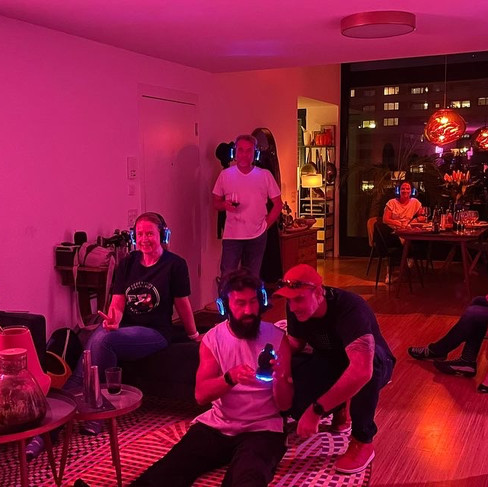Perfourmer Realtime Sound Sculpting
- 59 Perlen

- Oct 17, 2022
- 4 min read

As you have surely noticed, the event "Sonic Playgrounds" will take place on 26.11.2022 in Copenhagen and I have the great honor to play at this event as well. This is, for my current circumstances, a quite large event and surely I want to be well prepared for it.
I have created a master plan for this and the first milestone was reached yesterday with the first premiere of a live set based on Ableton. I had invited 15 friends to a BBQ party at my place and made a little "Silent Concert" out of it.
It's not the first time that I "beta-test" my sets this way. To gain experience (or if you simply lack bookings and need to exercise under live conditions), I can only recommend to play in front of your people! I will certainly do it again as I really love it.
Hardware Setup
The set comes with extremely reduced equipment, I wrote about it in another blogpost. The main aspect of the setup was its transportability, because I can't check in my synthesizers as luggage at the airport (the risk that it gets lost or damaged is simply to high) so all devices have to fit into a piece of hand luggage.
So the following devices are currently included:
Macbook Pro M1 16GB Ram
Motu M4 Audio / Midi Interface
Launchpad Mini MK3
Ableton Live 11 Suite
Originally I had a bigger Launchpad Pro, but the mini version is much lighter when traveling and does the same job as a clip launcher.
The setlist currently contains 5 tracks with a running time of about 30-35 minutes.
In the run-up I had to fight with massive problems in the Ableton suite. It transposed arbitrarily the pitch of the external instrument clips. I still haven't figured out by what incoming commands this happens. MIDI monitoring didn't yield any results, I had initially thought it was unwanted CC coming from the controller. In the end it helped to disable the MIDI input of the affected tracks. Since I don't play these live on the controller, its OK for now.
Feedback from the audience
Super valuable! The feedback was very positive and I was mega happy that the entire set worked out so well. The feedback from the audience was extremely helpful and I will incorporate many of them into the development steps of the set.
A key aspect, and one that I was very happy about: people are extremely positive about the warm sounds (coming from the Vermona of course) and its little bumps. "Organic", "warm", "vintage", "deep" or "lively" are some of the terms I picked up after the concert.
And these terms bring me to the essential change in my sound design process and the main topic of this blogpost.
Preset-less real-time Sound Design
What I already noticed during the development and rehearsal of the set: I perform much more relaxed, because I can completely concentrate on one device. With the pure hardware sets I used before, I was usually overwhelmed with the possibilities and very often I forgot to use the entire range of elements that were intended for a pattern play. By reducing this to one hardware instrument only, all of this is eliminated.
Now I don't own the Perfourmer for a long time and in the beginning I wrote down the patches on paper to be able to recall them later - we're so used to save sounds as presets and preserve our work for later!
However, while working on my last major project "Shopping Bag", I found out that this technique is quite cumbersome. So I really wanted to get rid of this "preset way of thinking" and work more fluidly. This is sometimes quite difficult when you have grown up with the concept of presets.
Be that as it may. In the meantime I know the device better and can configure it much faster. First I usually set the essential properties of the sound - envelope, filter - and then refine the sound "on the go". It may well happen that I loop through a scene in Ableton a few extra times while modeling the sound in real time.
This makes the tracks sound a little different each time, naturally, and the sound design process becomes part of the whole performance. Not only do I enjoy this, I find it gives the whole set a very lively touch, which the audience also registers as well.
Problems with the analog synthesizer
Now, during the last few weeks of working with this setup, the PerFourMer's "drift" (something many analog gear has in common) turned out to be a little extra hurdle. While the circuits warm up, the pitch of the 4 voices partially drifts, and in the interaction with the software-based instruments you can hear this drift massively.
That's why the first thing in my new sets is a "test scene": Each voice plays an A4 tone (440 Hz). PerFourMer MKII has a tuning feature with which one can produce a continuous 440 Hz tone and thus tune the 4 instrument voices.
Nevertheless, it has happened to me more often that retuning is necessary during the performance. But I now see this as part of the organic feel and it no longer bothers me when a voice plays slightly out of tune.











Comments